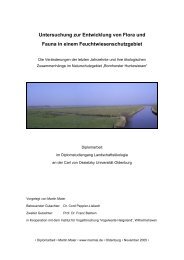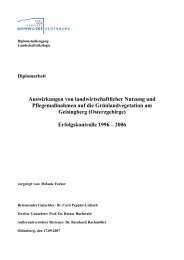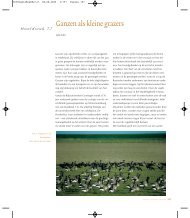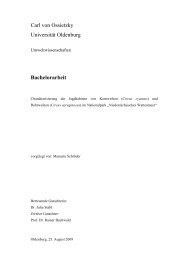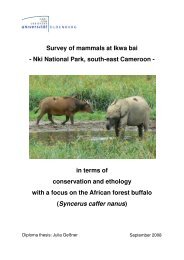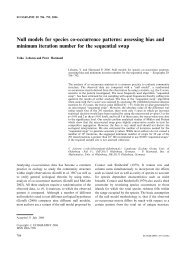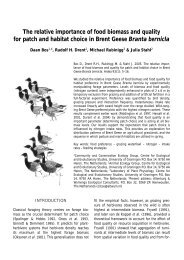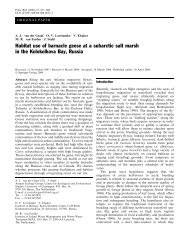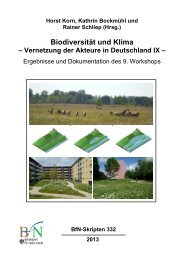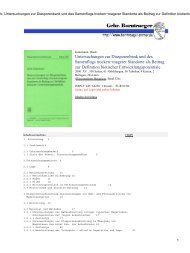The use of habitat models in conservation of rare and endangered ...
The use of habitat models in conservation of rare and endangered ...
The use of habitat models in conservation of rare and endangered ...
You also want an ePaper? Increase the reach of your titles
YUMPU automatically turns print PDFs into web optimized ePapers that Google loves.
256<br />
Figure 8. Habitat suitability map for Neophilaenus m<strong>in</strong>or. Non-brownfield sites (sealed areas: e.g. roads, build<strong>in</strong>gs, conta<strong>in</strong>er parks;<br />
farml<strong>and</strong>: mostly wet grassl<strong>and</strong>) are considered per se as unsuitable <strong>habitat</strong>s (matrix) <strong>and</strong> dotted on the map.<br />
succession. This quantitative <strong>in</strong>formation may be<br />
essential for the <strong>conservation</strong> <strong>of</strong> species <strong>in</strong><br />
brownfields. It was shown that the species under<br />
study are restricted to the early or <strong>in</strong>termediate<br />
stages <strong>of</strong> brownfield succession. Once sites become<br />
too old, these species are likely to disappear. Small<br />
et al. (2003) found for carabid beetles that the<br />
most species rich assemblages are found on early<br />
successional sites that can be between 6 <strong>and</strong><br />
20 years old. For <strong>conservation</strong>, this implies that<br />
protection <strong>of</strong> exist<strong>in</strong>g brownfield-sites without<br />
management will ca<strong>use</strong> many species to disappear<br />
over time. In order to preserve high biodiversity,<br />
one should focus on the duration <strong>of</strong> the brownfield<br />
stage with<strong>in</strong> the cycle <strong>of</strong> emergence, succession <strong>and</strong><br />
demolition <strong>of</strong> brownfields sites. A constant stock<br />
<strong>of</strong> brownfields <strong>of</strong> young <strong>and</strong> <strong>in</strong>termediate age<br />
with<strong>in</strong> an <strong>in</strong>dustrial area preserves the typical<br />
species assemblage.<br />
<strong>The</strong> case studies also showed that <strong>in</strong> some<br />
species it is possible to build <strong>habitat</strong> <strong>models</strong> with<br />
good performance us<strong>in</strong>g only a few <strong>habitat</strong><br />
parameters. For <strong>in</strong>stance, <strong>in</strong> Verdanus bensoni<br />
two parameters were sufficient to reach a high<br />
correct classification rate. For <strong>conservation</strong> purpose,<br />
those <strong>habitat</strong> <strong>models</strong> may be a tool to<br />
identify potential <strong>habitat</strong> rely<strong>in</strong>g on only a small<br />
number <strong>of</strong> environmental parameters. Even<br />
though a large number <strong>of</strong> parameters might be<br />
necessary to detect the driv<strong>in</strong>g forces <strong>and</strong> build<br />
well perform<strong>in</strong>g <strong>models</strong>, once these parameters<br />
are known, <strong>models</strong> can easily be applied to other<br />
regions, assum<strong>in</strong>g the availability <strong>of</strong> data for the<br />
parameters. In the light <strong>of</strong> <strong>in</strong>creas<strong>in</strong>g availability<br />
<strong>of</strong> area-wide environmental data (e.g. from satellite<br />
imagery or public GIS databases) this<br />
prerequisite will be easier to meet <strong>in</strong> future.<br />
However, some variables, like the ones describ<strong>in</strong>g<br />
aspects <strong>of</strong> vegetation structure <strong>in</strong> a detailed<br />
way, can not be obta<strong>in</strong>ed area-wide by these<br />
methods. Still, these variables are <strong>of</strong> great<br />
importance when study<strong>in</strong>g a species’ ecological<br />
needs. Hence, for <strong>habitat</strong> suitability maps, these<br />
variables have to be substituted by ones that are<br />
available area-wide. <strong>The</strong> application <strong>of</strong> <strong>habitat</strong><br />
suitability maps <strong>in</strong> <strong>conservation</strong> may easily<br />
identify <strong>and</strong> map areas for protection (e.g.<br />
Cabeza et al. 2004). However, there are some issues<br />
to consider when apply<strong>in</strong>g <strong>habitat</strong> <strong>models</strong> <strong>and</strong><br />
<strong>habitat</strong> suitability maps. First, species’ absences<br />
can never be recorded with the same certa<strong>in</strong>ty as<br />
species’ presences. Kleyer et al. (1999/2000) suggest<br />
regard<strong>in</strong>g presence <strong>and</strong> absence as a species-specific<br />
characteristic. Second, false-positive predictions do<br />
not necessarily <strong>in</strong>dicate a poor model fit, s<strong>in</strong>ce plots<br />
recorded as non-<strong>use</strong> are not always unsuitable<br />
<strong>habitat</strong> (Capen et al. 1986). This is particularly<br />
true <strong>in</strong> decl<strong>in</strong><strong>in</strong>g populations, where many falsepositive<br />
predictions might result (Wilson et al.<br />
2005): due to an <strong>in</strong>creased ext<strong>in</strong>ction rate, suitable<br />
<strong>habitat</strong> might not be <strong>in</strong>habited. Thus, <strong>habitat</strong><br />
suitability maps may help to identify areas for the




